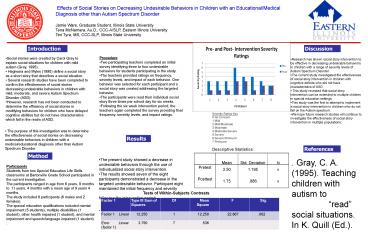Participants PowerPoint PPT Presentation
1 / 1
Title: Participants
1
Effects of Social Stories on Decreasing
Undesirable Behaviors in Children with an
Educational/Medical Diagnosis other than Autism
Spectrum Disorder Jamie Ware, Graduate Student,
Illinois State University Tena McNamara, Au.D.,
CCC-A/SLP, Eastern Illinois University Teri Tyra,
MS, CCC-SLP, Illinois State University
- Procedure
- Two participating teachers completed an initial
survey identifying three to four undesirable
behaviors for students participating in the
study. - The teachers provided ratings on frequency,
severity levels, and impact of each behavior. One
behavior was selected for each participant and a
social story was created addressing the targeted
behavior. - The participants were read their individual
social story three times per school day for six
weeks. - Following the six week intervention period, the
teachers again completed the survey providing
final frequency, severity levels, and impact
ratings.
- Social stories were created by Carol Gray to
explain social situations for children with mild
autism (Gray, 1995). - Hagiwara and Myles (1990) define a social story
as a short story that describes a social
situation. - Several research studies have been completed to
confirm the effectiveness of social stories
decreasing undesirable behaviors in children with
mild, moderate, and severe Autism Spectrum
Disorder (ASD). - However, research has not been conducted to
determine the efficiency of social stories in
modifying behaviors for children who have delayed
cognitive abilities but do not have
characteristics which fall in the realm of ASD.
- Research has shown social story intervention to
be effective in decreasing undesirable behaviors
in children with a range of severity levels of
Autism Spectrum Disorder. - The current study investigated the effectiveness
of social story intervention in children with
cognitive deficits who did not have
characteristics of ASD. - This study revealed that social story
intervention can be extended to multiple children
in special education settings. - This study was the first to attempt to implement
a social story intervention in children who do
not fall on the Autism spectrum. - We hope future research studies will continue to
investigate the effectiveness of social story
intervention in multiple populations.
Severity Rating Key 0 No Concern 1 Mild 2
Mild/Moderate 3 Moderate 4 Moderate/Severe 5
Severe 6 Severe/Profound 7 Profound Descriptive
Statistics
- The purpose of this investigation was to
determine the effectiveness of social stories on
decreasing undesirable behaviors in children with
a medical/educational diagnosis other than Autism
Spectrum Disorder.
Results
- The present study showed a decrease in
undesirable behaviors through the use of
individualized social story intervention. - The results showed seven of the eight
participants demonstrated a decrease in the
targeted undesirable behavior. Participant eight
maintained the initial frequency and severity
following the intervention period.
. Gray, C. A. (1995). Teaching children with
autism to read social situations. In K. Quill
(Ed.). Teaching children with autism
Strategies to enhance communication and
socialization (pp. 219-242). New York
Delmar. Gray, C.A. (2000). The New Social Story
Book (Illustrated Version). Arlington, TX
Future Horizons, Inc. Hagiwara, T. Smith
Myles, B. (1999). A multimedia social story
intervention Teaching skills to children with
autism. Focus on autism and other developmental
disabilities, 14 (2), 82-95. Contact
information jlware_at_ilstu.edu
tmcnamara_at_eiu.edu
tltyra_at_iltsu.edu
Participants Students from two Special Education
Life Skills classrooms at Bartonville Grade
School participated in the current investigation.
The participants ranged in age from 6 years, 9
months to 11 years, 4 months with a mean age of
9 years 4 months. The study included 8
participants (6 males and 2 females). The
special education qualifications included mental
impairment (5 students), multiple disabilities (1
student), other health impaired (1 student), and
mental impairment and speech/language impaired (1
student) .
Tests of Within-Subjects
Contrasts
.

